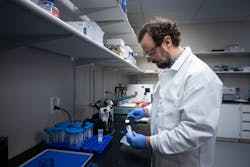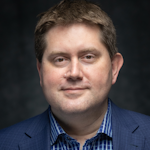Dental implants restore a patient’s ability to chew when a native tooth has been damaged beyond repair and must be extracted. When an implantation is successful, an onlooker would never know that the implanted tooth is not a natural part of the patient’s smile.
In the US alone, approximately 5 million implants are placed every year.1 However, their failure rate remains unacceptably high. In some patients, up to 20% of dental implants fail,2 with a high correlation with patients who smoke, are elderly, or suffer from periodontitis.
Dental implant surgery involves the removal of the damaged or decayed tooth. Next, the socket is filled with bone, and the implant is attached by a screw, which gets drilled into the new bone. But in some cases, the screw does not set correctly, and the implant loosens. Infectious diseases of the gum and bone around a dental implant cause inflammation and, ultimately, loss of supporting bone around the implant (known as peri-implantitis).
Regenerating alveolar bone
With approximately 650,000 cases of peri-implantitis every year in the US,3,4 a periodontist’s playbook currently involves a few different steps. Treatment of peri-implantitis requires control of the infection, detoxification of the implant surface, and regeneration of alveolar (jaw) bone. Methods for regenerating alveolar bone on the market today are limited and lack efficacy, sometimes risking off-target effects. The most powerful regenerative biologic—recombinant human bone morphogenetic protein-2 (rhBMP-2)—is good at growing bone, but it can cause inflammation and bone growth in unwanted areas.
Advances in protein engineering mean that soon biologics like AMP-2 (Theradaptive), a targetable variant of BMP-2, will be delivered to the alveolar bone in a more precise fashion, negating off-target effects. This will also transform standards of care for jaw reconstruction surgery, sinus ridge augmentation, or socket augmentation repair.
Peri-implantitis occurs in most cases due to a reaction to infectious disease at the location where bone resorbs around a dental implant. The inflammation of bone and tissues at the implant site results in a loosening of the implant to the point where it is no longer viable. When inflammation occurs, macrophages surround the infection to kill microorganisms and remove dead cells, but this process can inadvertently contribute to bone resorption. Macrophages release cytokines like interleukin 1 (IL-1), exacerbating inflammation and activating peri-implantitis. As a result, studies have shown that macrophages are prevalent in patients with peri-implantitis.5
To counteract this, periodontists perform a procedure to debride and disinfect the bone to eliminate bacteria, and then fill the area with a void filler. Unfortunately, once a natural tooth has been lost, bone often quickly resorbs, thinning the alveolar ridge into a narrow ridge of bone. Because there is no longer a flat surface into which an implant can be placed, the bone must first be rebuilt around the area where the tooth was. The most challenging cases involve patients with a severe lack of bone around the alveolar ridge. This is a particularly pronounced problem for elderly patients who lose bone mass as they grow older and so lack the sufficient bone stock to hold an implant. Comorbidities such as diabetes and smoking also result in low bone stock and lower implantation success rates.
To bulk up bone around an implant, periodontists may use an inert ceramic bone filler or allograft bone from a human tissue bank. As a product with donor variability, there is debate as to the quantity of growth factors present in allograft that would promote regrowth of bone around the implant. For this reason, allograft does not often generate enough bone. Although autograft (which involves harvesting bone from another area of the body such as the sinuses) may aid in bone regeneration, it can cause pain at the donor site and unwanted side effects during the harvesting process. Fundamentally, experts disagree about what is the most effective method of regenerating bone. Periodontists are in critical need of a substance that will promote robust and precise bone tissue growth to ensure safe and secure placement of implants. Studies suggest that robust bone regeneration can also reduce the incidence of infection.
Advances in regenerative medicine
Advances in regenerative medicine promise more tools in the toolkit for periodontists and craniofacial and maxillofacial surgeons in the near future. One relatively new way to reinforce an implant uses a bulking agent with bone growth properties. For example, with the bone-inducing power of rhBMP-2, periodontists can use products such as Infuse (Medtronic) to induce bone formation around an implant on the alveolar ridge. Similarly, craniofacial and maxillofacial surgeons may use rhBMP-2 for sinus ridge or alveolar ridge augmentation to bulk up bone in the case of bone defects, jaw reconstruction, socket augmentation repair, or a dental implant augmentation.
Native BMP-2 occurs naturally as an important part of the body’s bone-healing response. Unfortunately, rhBMP-2 comes with some concerning off-target effects when introduced into the body. Adverse safety outcomes occur because rhBMP-2 is not well-targeted and diffuses away from the site where the clinician/surgeon is trying to regrow bone. This may cause inflammation, severe swelling, and, more alarming still, unwanted bone formation outside the intended location. When periodontists or surgeons are working around the sinus ridge, unwanted inflammation can affect a patient’s ability to breathe, making the use of rhBMP-2 a risky decision. Because of this, dentists use rhBMP-2 sparingly. Growing large volumes of bone without precise delivery of the biologic translates to a significant added cost for patients, which is not covered by insurance.
Protein engineering promises a not-too-distant future where biologics with a potent bone-growth factor can be delivered in a highly targeted manner, which means they will only be active at the site where they are required. Native rhBMP-2 does not bind well to implants or the surrounding alveolar ridge. To overcome this, Theradaptive used a combination of in vitro and computational methods to design a novel material-binding variant of rhBMP-2 called AMP-2. This novel protein allows for sustained osteoinduction with high spatial precision.
Ongoing research
More than 20 preclinical animal model studies that have not yet been published in peer-reviewed journals have been conducted, demonstrating the ability of AMP-2 to beat the standard of care in its ability to form bone precisely where it is needed. Although very early in development and not yet ready for clinical use, AMP-2 shows promise to improve the rate of success for dental implantations and other facial reconstruction operations—without the dangerous side effects associated with native rhBMP-2. Positive benefits of precisely delivering bioactive molecules also include reduced costs for doctors and patients as far less protein is required for the same result.
The most recent innovations in dental implantation technology have seen immediate implants become increasingly more common. In some cases, teeth can be extracted and implants placed immediately, reducing the number of surgical procedures. However, in many cases, three to six months of healing time is still required before artificial teeth can be placed on the implants. Biologics that can regenerate alveolar bone will speed up the healing process and may mean immediate implantation becomes standard practice. As AMP-2 begins to enter the dental clinic in the next 24 months, dental implant patients who feel like they are failed by current implant procedures can look forward to less painful, more efficacious treatments.
Editor’s note: This article originally appeared in Perio-Implant Advisory, a chairside resource for dentists and hygienists that focuses on periodontal- and implant-related issues. Read more articles and subscribe to the newsletter.
References
- Tooth implant vs. bridge: what top dentists are recommending. American Dental Association. https://marketplace.ada.org/blog/dental-business/tooth-implant-vs-bridge-what-top-dentists-are-recommending/
- Higuera V. What to know about dental implant complications and failure. Healthline. Updated September 5, 2018. https://www.healthline.com/health/dental-implant-problems
- Dental implants market size, share & trends analysis report by implant type (zirconium, titanium), by region (North America, Europe, Asia Pacific, Latin America, MEA), and segment forecasts, 2023 – 2030. Report ID: GVR-1-68038-566-3. Grand View Research. https://www.grandviewresearch.com/industry-analysis/dental-implants-market
- Diaz P, Gonzalo E, Villagra LJG, Miegimolle B, Suarez MJ. What is the prevalence of peri-implantitis? A systematic review and meta-analysis. BMC Oral Health. 2022;22(1):449. doi:10.1186/s12903-022-02493-8
- Baseri M, Radmand F, Hamedi R, Yousefi M, Kafil HS. Immunological aspects of dental implant rejection. Biomed Res Int. 2020;2020:7279509. doi:10.1155/2020/7279509









